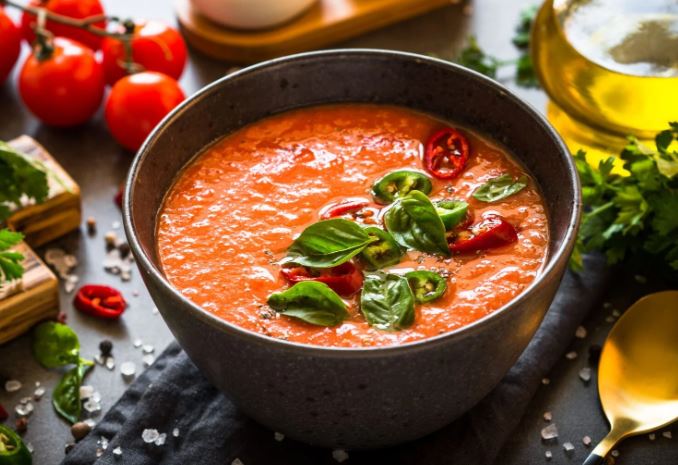Gaspacho is a spicy soup made from chopped raw veggies such as tomato, onion, and pepper, and onion, and sometimes it’s used watermelon and is served cold. Cold and fresh gaspacho is an ideal choice to taste the peak of summer days without heating up your kitchen. This recipe is well-called as a classic cold Spanish soup. This classic dish in Spanish cuisine originated from the Andalusian region South of Spain.
If you have the chance to visit Spain, you’ll find this gaspacho recipe here varies slightly from the region. And of course, there are a million non-traditional ingredients and twists to make this modern cook love to try too.
However, read on to the article to know more about the recipe, what is it, what ingredients are needed to make it, and how to make it.
What Is Gaspacho?
The southern Spanish region of Andalusia is where gazpacho originated. The recipe calls for puréed tomatoes as well as cucumber, sweet bell peppers, onions, garlic, and olive oil. Additionally, melons can be used to make fruit- or cucumber-based gazpacho. Like so many other fresh foods, there are as many methods to make gazpacho as there are seeds in a tomato.
Ingredients For Making The Spanish Gaspacho:
Because it doesn’t require heating up your stove or oven and because all of the fresh ingredients are in season right now, gazpacho is the ideal summer soup. Just use a cutting board to prepare your ingredients. After that, your blender or food processor will handle the rest. This homemade gazpacho recipe requires the following ingredients:
Tomatoes:
For traditional gazpacho, Roma tomatoes or what we refer to as “branch tomatoes” in Spain (medium, round, soft-skinned tomatoes on the vine) are required. However, any fresh, ripe, and juicy tomato will do. Your tomatoes don’t need to be peeled for gazpacho, but I do suggest coring them instead (scoop out the white flesh and seeds).
Cucumber:
In Spain, 6-inch Persian or Kirby cucumbers that have been peeled and seeded are most frequently used. But typically I’ll just throw in half of an English cucumber. whichever suits you best!
Green bell pepper:
According to several of my Spanish friends, gazpacho must particularly have green bell peppers to be considered truly Spanish. However, I would assert that you can use any hue of bell pepper you have on hand.
Bread:
Remaining white bread gives real gazpacho its distinctive texture, slightly thickening it and balancing the flavors. For the best texture, our local friends advised us to throw away the crusts. Then, to aid in blending the bread, you can either:
- Alternatively, you might puree the gazpacho first, then pierce the bread slice into the center of the soup and let it sit there for 10 minutes to soften before mixing it in.
- Simply rinse it under the tap, totally submerge it in water, then thoroughly ring it out with your hands. Add the bread to the soup’s other components and purée.
Red onion:
Just the peeled half of a little red onion. Or you can use one huge clove of garlic or two little cloves.
Olive oil:
A significant amount of olive oil is used in many traditional gazpacho recipes. But in Spain today, the amount of oil is frequently reduced to make the soup a little bit healthier. Only 3 tablespoons are required for this recipe.
Sherry vinegar:
Sherry is a specialty of Andalucia. In Spain, gazpacho is always made with sherry vinegar (Vinagre de Jerez), as is obvious. Having said that, red wine vinegar can be substituted if sherry vinegar is unavailable at your local grocery shop.
Cumin is a common component in gaspacho in the south of Spain because of the area’s proximity to Morocco. One of our friends in Andalusia taught me the trick of adding cumin to your gazpacho. I adore the delicate, earthy flavor it gives this recipe.

How To Make Gaspacho?
Making homemade gazpacho soup is as easy as:
- The soup should be pureed by placing all of the ingredients in a blender or food processor and processing for one minute, or until the gazpacho is the appropriate consistency. (I adore how silky mine is.)
- Refrigerate the soup for 4 hours, or until it is thoroughly chilled, in a sealed container.
- When ready to serve, garnish the soup with your preferred toppings and serve it cool.
Toppings For Gaspacho Soup:
Toppings are a necessity in my book with such a straightforward blended soup! To gazpacho, I enjoy adding any combination of the following:
- Homemade croutons are simple to create with any leftover bread that is available.
- Fresh herbs: Some of our favorites include basil, thyme, oregano, rosemary, and/or chives.
- In my opinion, freshly cracked black pepper is a necessity.
- Olive oil: It’s customary in Spain to sprinkle more oil on top.
- If you want a creamier soup, a sprinkle of cream (or sour cream) can be good.
- In the south of Spain, gazpacho is also well-liked with the usual toppings of Spanish ham and chopped hard-boiled eggs.
Or, of course, the most typical method is to simply top the dish with a handful of the leftover chopped vegetables from the gazpacho (such as tomato, green pepper, onion, or cucumber). Whatever appeals to you!
How To Serve Gaspacho?
Gazpacho soup can be served in a bowl or mug and topped any way you like. Alternatively, many establishments in Spain simply serve gazpacho over ice in cups with a straw, which I really enjoy! (The images are below.)
One thing to keep in mind when serving gazpacho is that it must be very cold. To ensure that it has enough time to cool off in the fridge before your meal, plan to combine the recipe a few hours before serving.
Add Possible Variations:
There are obviously countless ways you may modify your gazpacho, even though the recipe below is for a classic tomato gazpacho. You might:
Add fruit: Here in Spain, red gazpacho is frequently supplemented with watermelon, cantaloupe, and strawberries. (My recipe for watermelon gazpacho is provided below.)
Add veggies: Beets, zucchini, and corn are additional popular vegetables to include.
Add more herbs: You are welcome to include any more fresh herbs, including chives, basil, rosemary, and thyme.
Add some spice: Since Spain nearly never uses heat in its cuisine, this is not a frequent addition to gazpacho there. However, for an added kick, I occasionally enjoy adding a few slices of jalapeno or serrano to this recipe.
4 Types Of Gaspacho To Try:
1. Classic Gazpacho: Gazpacho In The Style Of Southern Spain
Vine-ripened tomatoes, peppers, and cucumbers are combined with pungent garlic and luscious olive oil in this classic gazpacho dish. There is also a sneaky addition of crusty bread to give the mixture heft and substance. The preparation just takes 20 minutes, but the tastiest soup of summer needs to rest in the fridge for at least an hour. Before serving, drizzle with additional olive oil and balsamic vinegar.
2. Low-Carb Gazpacho: A Simple And Delicious Gazpacho
In this variation, there is no bread and the soup is served straight from the blender to the bowl without a break in the refrigerator. To make the gazpacho a chunkier texture, some reviewers blended only half the ingredients, and others substituted lemon juice for the vinegar. All is well.
3. Gazpacho For Seafood Lovers: Shrimp Gazpacho
This chilled soup departs from the norm of gazpacho by using a tomato and clam juice cocktail as a basis. For texture and flavor, you’ll also add chopped avocado, cucumber, onion, fresh tomatoes, lemon juice, and cilantro. The shrimp, what about them? You may either serve it on top of the gazpacho or add it to it.
4. Watermelon Gaspacho By Julia: A Fresh & Fruity Gazpacho
Not one tomato in this rendition. You’ll taste pineapple juice, cucumbers, juicy red bell peppers, mint, and ginger instead. Things are spiced up with onion and jalapeno pepper, while honey provides harmony. Cool, energizing, and with a kick.
Final Word:
A traditional cold soup from Spain, gazpacho is ideal for hot summer days. Traditionally, fresh tomatoes, cucumbers, red onions, and garlic are used in its preparation. We’re adding even more fresh farm vegetables to this recipe, and we’re also spiking the soup with Tabasco and Worcestershire sauce. For this soup, use only the best, most recent ingredients. Serve the soup with crusty bread and some chopped avocado on top for a Californian twist.










